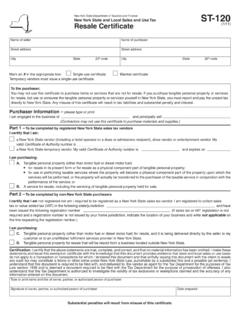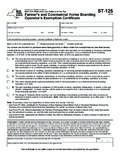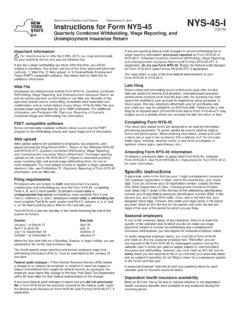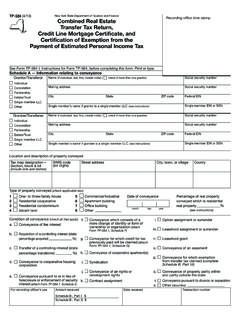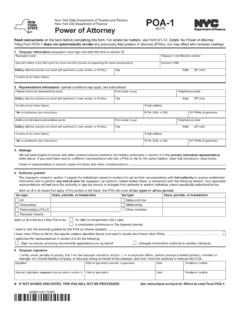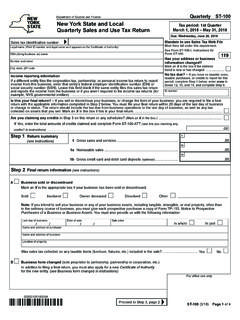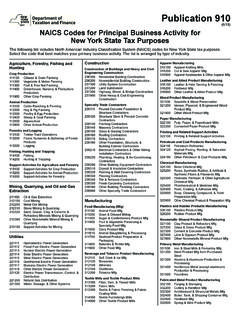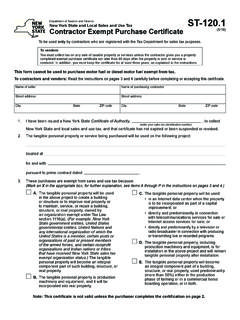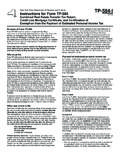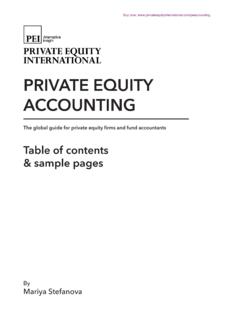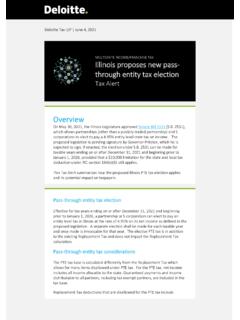Transcription of Pass-Through Entity Tax
1 W A Harriman Campus, Albany NY 12227 Technical Memorandum TSB-M-21(1)C, (1)I Corporation Tax Income Tax August 25, 2021 Pass-Through Entity Tax The Pass-Through Entity tax (PTET) under new Tax Law Article 24-A1 is an optional tax that partnerships or New York S corporations may annually elect to pay on certain income for tax years beginning on or after January 1, 2021. If a partnership or New York S corporation elects to pay PTET, partners, members, or shareholders of an electing partnership or New York S corporation ( electing Entity ) who are subject to tax under Article 22 may be eligible for a PTET credit on their New York State income tax returns. Who may make the election Only an authorized person may make this election on behalf of an eligible partnership or S corporation.
2 If the Entity is: Authorized persons include: a New York S corporation any officer, manager, or shareholder of the New York S corporation who is authorized under the law of the state where the corporation is incorporated or under the S corporation s organizational documents to make the election and who represents to having that authorization under penalty of perjury. a partnership any member, partner, owner, or other individual with authority to bind the Entity or sign returns under Tax Law 653. An eligible partnership is any partnership [including a limited liability company (LLC) treated as a partnership for New York and federal income tax purposes] that has a filing requirement under Tax Law 658(c)(1) and is not a publicly traded A partnership is eligible to make the election even if it has partners that are not eligible for a PTET credit including, but not limited to, corporate partners.
3 An eligible S corporation is any New York S corporation (including an LLC treated as an S corporation for New York and federal income tax purposes) as defined by Tax Law 208(1-A) that is subject to the fixed dollar minimum tax under Tax Law 209. The election period Eligible partnerships and S corporations may annually elect to pay PTET for tax years beginning on or after January 1, 2021. The election to opt into PTET must be made online on an annual basis and is irrevocable. 1 Chapter 59 of the Laws of 2021, Part C. 2 As defined in IRC 7704. - 2 - TSB-M-21(1)C, (1)I Corporation Tax Income Tax August 25, 2021 An electing Entity that is a calendar-year taxpayer for federal purposes must use a calendar-year basis to elect, file, and pay PTET.
4 An electing Entity that is a fiscal-year taxpayer must elect, file, and pay PTET for the calendar year in which its fiscal year ends. See Filing the annual PTET return and calculation of the PTET credits for further explanation. For tax years beginning on or after January 1, 2021, an authorized person can opt in to PTET on behalf of an eligible Entity through the Entity s Business Online Services account, now through October 15, 2021. If the Entity does not have a Business Online Services account, the authorized person will need to create one. For tax years beginning on or after January 1, 2022, the annual election may be made online on or after January 1 but no later than March 15. How to calculate Pass-Through Entity taxable income (PTE taxable income) PTET is imposed on the PTE taxable income of an electing Entity .
5 Generally, PTE taxable income includes all income, gain, loss, or deduction of an electing Entity that flows through to a direct partner, member, or shareholder for New York personal income tax purposes. A direct member, partner, or shareholder is any member, partner, or shareholder that is issued a federal Schedule K-1 by the electing Entity based on the member s, partner s or shareholder s direct ownership interest in the electing Entity . A federal Schedule K-1 issued to an Entity that is disregarded for tax purposes, such as a single member limited liability company, is treated as if issued directly to the individuals or entities that include the disregarded Entity s activity on their income tax returns. The calculation of PTE taxable income differs between electing New York S corporations and electing Electing New York S corporations An electing New York S corporation calculates its PTE taxable income by aggregating amounts of income, gain, loss or deduction that flow through for New York income tax purposes to direct members or shareholders who are taxable under Article 22.
6 Aggregated income and gain is reduced by any losses or deductions without regard to any limitations4 that would be imposed on the member s or shareholder s federal and New York State personal income tax returns. The electing S corporation must then apportion this net amount of taxable income to New York based on the apportionment rules of Article 9-A included in Tax Law 210-A. Electing Partnerships Before computing its PTE taxable income, an electing partnership is required to classify all direct members or partners that are taxable under Article 22 as a resident or nonresident of New York. Members or partners may not be classified as part-year residents for PTET 3 A limited liability company is required to use the rules for S corporations if it is treated as a New York S corporation for New York tax purposes and the rules for partnerships if it is treated as a partnership for tax purposes.
7 4 Examples of limitations include, but are not limited to, capital losses, passive activity losses, and basis limitations. - 3 - TSB-M-21(1)C, (1)I Corporation Tax Income Tax August 25, 2021 purposes. A member or partner should be treated as a resident if they are a resident of New York for New York personal income tax purposes for at least half of the year. All other members or partners should be treated as nonresidents. If a member or partner is a trust, the electing partnership must classify the trust as a resident or nonresident of New York State based on the residency status of the trust and not of the beneficiaries. An electing partnership s calculation of its PTE taxable income must include all items of income, gain, loss or deduction, to the extent they would flow through and be included in the taxable income of direct members or partners that are taxable under Article 22, including guaranteed payments.
8 A partnership must not include in its PTE taxable income any amounts of income, gain, loss, or deduction that flow through to a direct partner that is a partnership or an Entity not subject to tax under Article 22, even if the income is ultimately taxable to a partner under Article 22 through tiered partnerships. To compute its PTE taxable income, an electing partnership must compute both a resident PTE taxable income pool and a nonresident PTE taxable income pool and add these amounts together. This PTE taxable income calculation applies to partners or members who do not have a special allocation of profits that differs from their allocation of losses. If a special allocation is present, an electing partnership must take these allocations into account when computing each pool.
9 To compute its resident PTE taxable income pool, an electing partnership must aggregate any amounts of income and gain that flow through to resident individual members or partners and offset that amount by any losses or deductions that flow through to resident individual members or partners, without regard for any limitations4 that would be imposed on the member s or partner s federal and New York State personal income tax returns. To compute its nonresident PTE taxable income pool, an electing partnership must aggregate any amounts of income and gain derived from or connected with New York sources5 that flow through to nonresident individual members or partners and reduce that amount by any losses or deductions derived from or connected with New York sources that flow through to nonresident individual members or partners, without regard for any limitations4 that would be imposed on the member s or partner s federal and New York State personal income tax returns.
10 Example: An electing partnership has New York sourced ordinary income of $2 million flowing to nonresidents and ordinary income of $2 million and a capital loss of $1 million flowing to residents for the tax year. The nonresident PTE taxable income pool of the partnership would be $2 million, and the resident PTE taxable income pool of the partnership would be $1 million ($2 million ordinary income less $ 1 million capital loss). The PTE taxable income for the partnership would be $3 million ($2 million nonresident PTE taxable income plus $1 million resident PTE taxable income). 5 See Article 22 of the Tax Law. - 4 - TSB-M-21(1)C, (1)I Corporation Tax Income Tax August 25, 2021 How to calculate the PTET For each tax year beginning on or after January 1, 2021, PTET is imposed on each electing Entity s PTE taxable income.
